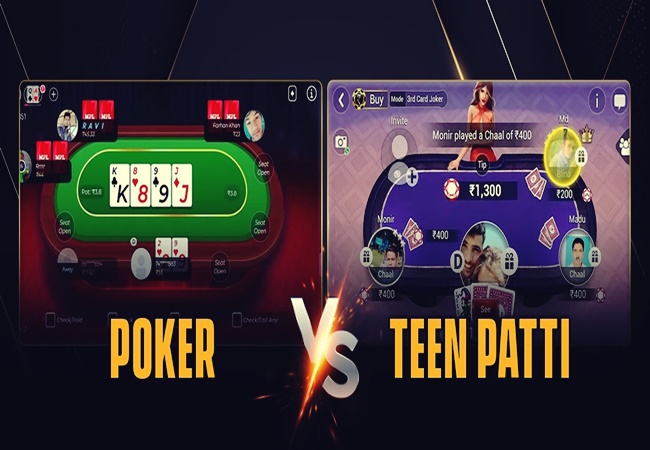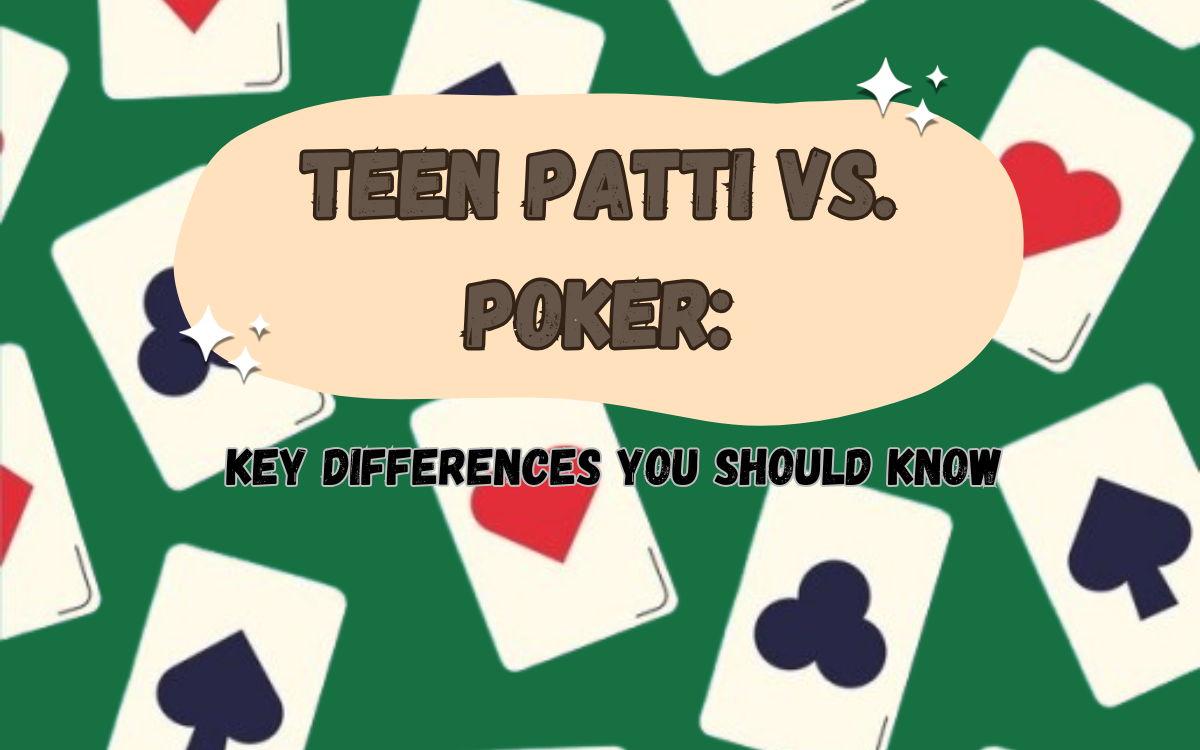Teen Patti vs. Poker: Key Differences You Should Know
Card games have been a source of entertainment and strategy for centuries, with different cultures developing their unique versions. Two of the most popular card games are Teen Patti and Poker game. While both games revolve around strategy, skill, and a bit of luck, they are fundamentally different in terms of rules, gameplay, and cultural significance. This article will explore the key differences between Teen Patti and Poker game to help you understand which game suits your interests and skillset better.

Origin and Cultural Significance
Teen Patti, also known as “Flash” or “Flush,” originated in the Indian subcontinent and is deeply embedded in the region’s culture. Often played during festivals like Diwali, Teen Patti is a social game enjoyed with family and friends. Its simple rules and fast-paced gameplay make Teen Patti online accessible to players of all ages, fostering a sense of community and celebration.
Poker game, on the other hand, has its roots in 19th-century America and has evolved into a global phenomenon. With several variants like Texas Hold’em, Omaha, and Seven-Card Stud, Poker game is a staple in casinos and professional tournaments worldwide. It is regarded as a game of skill, requiring players to master strategies, bluffing techniques, and mathematical probabilities.
Number of Cards and Players
In Teen Patti, the game is typically played with a standard 52-card deck, and each player is dealt three cards. The number of players can range from 3 to 7, although the game can accommodate more participants in casual settings.
Poker game, depending on the variant, usually involves 2 to 10 players and may require a combination of hole cards (private cards) and community cards (shared by all players). For example, in Texas Hold’em, each player receives two hole cards and can use up to five community cards to form their best hand.
Hand Rankings
Hand rankings in Teen Patti are relatively straightforward. From highest to lowest, the rankings are:
- Trail or Trio: Three cards of the same rank (e.g., 3♥, 3♦, 3♠)
- Pure Sequence: Three consecutive cards of the same suit (e.g., 5♥, 6♥, 7♥)
- Sequence: Three consecutive cards of any suit (e.g., 4♥, 5♣, 6♦)
- Color: Three cards of the same suit, not in sequence (e.g., 2♥, 5♥, 10♥)
- Pair: Two cards of the same rank (e.g., 8♠, 8♦, K♥)
- High Card: When no other hand is formed, the highest card determines the winner.
In Poker game, hand rankings are more complex and universally standardized. The hierarchy includes:
- Royal Flush: A, K, Q, J, 10 of the same suit
- Straight Flush: Five consecutive cards of the same suit
- Four of a Kind: Four cards of the same rank
- Full House: Three cards of one rank and two of another
- Flush: Five cards of the same suit, not in sequence
- Straight: Five consecutive cards of any suit
- Three of a Kind: Three cards of the same rank
- Two Pair: Two sets of pairs
- One Pair: Two cards of the same rank
- High Card: When no other hand is formed, the highest card decides the winner.
Betting Structures
The betting structure is another critical difference between Teen Patti and Poker game. In Teen Patti, the betting begins with an agreed-upon “boot amount,” and players take turns placing bets without fixed limits. Players can choose to bet “seen” (after looking at their cards) or “blind” (without looking at their cards), which adds an element of excitement and unpredictability.
Poker game, however, follows more structured betting rounds. In Texas Hold’em, for instance, the game begins with mandatory bets called the “small blind” and “big blind.” Betting occurs in multiple rounds: pre-flop, flop, turn, and river. Players can check, call, raise, or fold based on their hand strength and strategy. The betting limits can be fixed, pot-limit, or no-limit, depending on the game variant.
Strategy and Skill Level
Teen Patti is relatively easy to learn and relies more on intuition, bluffing, quick decision-making, and managing chips and tokens effectively. Since the game is fast-paced and involves fewer cards, players have limited opportunities to analyze their opponents or devise intricate strategies.
Poker game, particularly in its tournament formats, requires a higher skill level. Successful players often study game theory, probabilities, and opponent behavior. Bluffing plays a crucial role, but it must be balanced with sound decision-making and a deep understanding of hand rankings and pot odds.

Game Variants
Both Teen Patti and Poker game offer a variety of game variants, adding diversity and challenge to the gameplay.
Popular Teen Patti variants include:
- Muflis: The weakest hand wins instead of the strongest.
- Joker: One or more cards are designated as jokers and can substitute any card to form a better hand.
- AK47: Aces, Kings, Fours, and Sevens are treated as jokers.
- 999: The goal is to form a hand with a value closest to 9-9-9.
Popular Poker game variants include:
- Texas Hold’em: The most widely played variant, involving two hole cards and five community cards.
- Omaha: Players are dealt four hole cards and must use exactly two of them with three community cards.
- Seven-Card Stud: Each player receives seven cards, but only the best five-card hand counts.
- Razz: A lowball variant where the weakest hand wins.
Social vs. Competitive Environment
Teen Patti is predominantly a social game, bringing people together in a relaxed and festive atmosphere. While money can be involved, the stakes are generally low, and the emphasis is on enjoyment rather than competition.
Poker game, in contrast, is often played in highly competitive environments, especially in professional settings. High-stakes tournaments like the World Series of Poker (WSOP) attract players from around the globe, offering millions of dollars in prize money. The game demands mental endurance, discipline, and the ability to handle pressure.
Accessibility and Learning Curve
Teen Patti’s simplicity makes it highly accessible to beginners. The rules can be learned in a matter of minutes, and the game requires no prior experience or deep understanding of probabilities.
Poker, while easy to grasp at a basic level, has a steeper learning curve for those who wish to excel. Players need to invest time in learning different game variants, mastering strategies, and practicing consistently to become an online poker sensation.
Conclusion: Teen patti vs. poker game
In summary, Teen Patti and Poker cater to different types of players and occasions. Teen Patti is perfect for casual, social gatherings, offering a fun and fast-paced experience with simple rules. Poker, on the other hand, appeals to those who enjoy strategic thinking, competitive play, and the challenge of mastering a complex game.
Whether you’re drawn to the festive spirit of Teen Patti or the strategic depth of Poker, both games offer unique thrills and opportunities for skill development. Understanding their differences will help you choose the one that aligns with your interests and gaming style.








